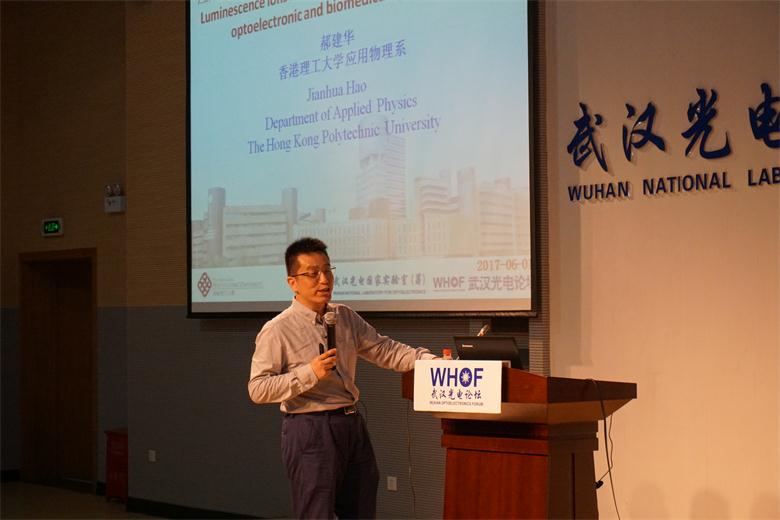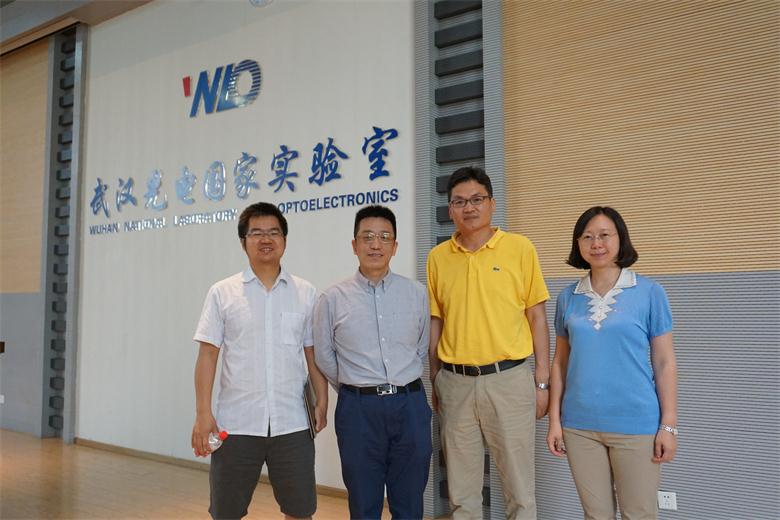WUHAN, China (June 1, 2017) - Wuhan Optoelectronics Forum No. 124 was successfully held in Auditorium A101 at Wuhan National Laboratory for Optoelectronics (WNLO) in the morning of June 1. Prof. Jianhua Hao from Hong Kong Polytechnic University delivered an exciting talk entitled Luminescence Ions in Advanced Materials and Devices for Optoelectronic and Biomedical Applications. Prof. ZhiHong Zhang, from Britton Chance Center for Biomedical Photonics chaired the forum. Dr. Song Xia, Chair of WNLO committee, awarded Prof. Hao the forum medal.
Metal ions-activated materials and devices have been widely applied in both scientific research and practical fields. The ability of a broad range of luminescent ions to generate fascinating emissions has played important roles in multifunctional applications. Several aspects of my group’s recent works will be introduced in my talk. Firstly, lanthanide-doped upconversion fluorescent nanocrystals as probes or contrast agents are used in multimodal bioimaging techniques, including fluorescence, MRI, X-ray and CT. Biosensors with both high sensitivity and rapid response are greatly desired for enabling rapid and sensitive detection of various virus gene in a cost-effective way. We have developed upconversion nano biosensor for virus detection. Secondly, my group have developed luminescent ion-doped composites, which can sense or harvest various stimuli. Magnetic-induced luminescence (MIL) has been proposed and realized by coupling magnetic field to piezophotonics. Moreover, the ultimate goal of making nanoscale electronic and optoelectronic devices stimulates atomically thin two-dimensional (2D) material research. We have introduced rare-earth dopants into 2D semiconductors and realize down-/up-conversion luminescence. Lastly, we have demonstrated metal ion incorporated and environmentally friendly triboelectric nanogenerators converting ambient mechanical energy into electricity and light-emissions. The works may contribute to future energy devices and self-powered sensors.
Jianhua Hao is a Full Professor, Associate Head and DRC Chair in the Department of Applied Physics at the Hong Kong Polytechnic University (PolyU). Prof. Hao received his Bachelor, Master and Doctoral degrees at Huazhong University of Science and Technology (HUST), China. After working at HUST, Penn State University, USA, University of Guelph, Canada and the University of Hong Kong, Prof. Hao joined the faculty in PolyU in 2006. Prof. Hao has published over 210 SCI papers. He has been listed as one of Most Cited Scientists in Materials Science by ESI. He is the first inventor of 5 US patents. Prof. Hao has been teaching “Semiconductor Materials & Devices”, “Display Technology” and other courses. As Chief Supervisor, he has supervised more than 20 PhD and MPhil postgraduate students and many Postdocs/RAs in PolyU. Prof. Hao has been PI in 14 government external competitive grants in PolyU. He has received some awards, including Faculty Award for Outstanding Performance/Achievement in Research & Scholarly-Individual in PolyU, Nanoscience Research Leader Award, Materials Research Contribution Award, and Special Merit Award and Gold Medal with the Congratulations of Jury at the 45thInternational Exhibition of Inventions of Geneva. He serves as Editorial Board Member/Senior Editor for several international journals, such as Scientific Reports(NPG)and Advanced Optical Materials (Wiley). He is now Vice-President of Physical Society of Hong Kong (2015-2017). He was General Chair/Session Chair/Organizing Committee Member in many international conferences and also invited to give a number of Plenary/Keynote/Invited Lectures in various conferences. Prof. Hao’s current research interests include (1) Luminescence and phosphors for photonic, energy and biomedical applications; (2) Functional thin-films, two-dimensional layered materials and heterostructures (Hao research group website: http://ap.polyu.edu.hk/apjhhao/).

